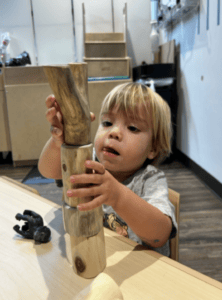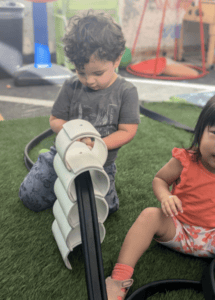
Play is the foundation of childhood development, and for children aged 18 months to 6 years, it’s their primary way of learning. One of the most natural and beneficial play-based activities for young children is stacking. Whether it’s building towers with blocks, balancing cups, or arranging objects, stacking encourages essential skills that lay the groundwork for lifelong learning.
Why Stacking is More Than Just Play
Stacking may seem simple, but it’s packed with developmental benefits for toddlers and preschoolers. Here’s what your child learns when they stack:
- Fine Motor Skills Development
- Picking up and placing objects strengthens hand-eye coordination and finger dexterity. These skills are crucial for later tasks like writing and using tools.
- Problem-Solving Abilities
- Children explore balance, gravity, and structure as they figure out how to prevent their towers from toppling.
- Cognitive Growth
- Stacking introduces concepts like size, weight, and spatial awareness, which are foundational for math and science learning.
- Social and Emotional Skills
- When stacking is done in groups, children learn teamwork, patience, and the joy of sharing accomplishments with peers.
- Language Development
- Parents and teachers can use stacking time to introduce new vocabulary, such as “tall,” “short,” “balance,” and “collapse.”
How Parents Can Incorporate Stacking at Home
Creating opportunities for stacking at home is simple and cost-effective. Here are a few ideas:
- Everyday Items as Play Tools
- Use plastic cups, canned goods, or even books as stacking materials. Encourage your child to experiment with different shapes and sizes.
- Set Challenges
- Make it a game! “Can you build a tower taller than your teddy bear?” or “Let’s see if we can stack all the blocks before dinner!”
- Incorporate Themes
- Use seasonal items like pumpkins in the fall or beach toys in the summer to keep stacking activities fresh and engaging.
- Storytelling with Stacks
- Encourage creativity by integrating stacking into storytelling. For example, “Let’s build a castle for the princess!”
- Model and Observe
- Show them how to stack and then let them take over. Ask open-ended questions like, “What happens if we put the big block on top of the small one?”
The Role of Preschool in Play-Based Learning
While at-home activities are valuable, a structured preschool program enhances these experiences. At Pillar Childcare, our play-based curriculum uses activities like stacking to foster learning and development in meaningful ways.
- Professional Guidance
- Our trained educators understand the developmental milestones for each age group and design activities to meet those needs.
- Social Interaction
- In a preschool setting, children engage with peers, learning to cooperate, share, and resolve conflicts—skills that are hard to replicate in solo play at home.
- Access to Resources
- Our program provides a variety of high-quality materials that encourage creativity and exploration, from blocks and puzzles to hands-on science kits.
- Learning Through Play
- At Pillar Childcare, every play activity, including stacking, is intentionally designed to build cognitive, physical, and emotional skills.
- Preparation for Future Learning
- A strong preschool foundation sets the stage for success in kindergarten and beyond. Play-based learning develops curiosity, critical thinking, and a love of learning.
Why Preschool is Crucial for Your Child’s Development

Research consistently shows that children who attend preschool have a head start in key developmental areas. Here’s why:
- Early Social Skills
- Interacting with peers teaches cooperation, empathy, and communication.
- Cognitive Advantages
- Preschool introduces structured learning in a fun, low-pressure environment. Children build problem-solving skills and develop an early understanding of concepts like numbers and patterns.
- Emotional Growth
- Being part of a group helps children learn to manage their emotions, deal with frustration, and build confidence.
- Physical Development
- Activities like stacking improve fine and gross motor skills, which are critical for tasks like writing and sports.
- Lifelong Benefits
- Studies show that children who attend high-quality preschool programs perform better academically and socially throughout their school years.
How Pillar Childcare Helps Your Child Thrive
At Pillar Childcare, we believe that learning should be joyful. Our program integrates stacking and other play-based activities into a curriculum designed to nurture every aspect of your child’s development.
- Daily Play-Based Activities: From stacking to role-playing, our classrooms are filled with opportunities for hands-on learning.
- Individualized Attention: We tailor activities to suit the unique needs of each child, ensuring they’re challenged and supported.
- Strong Parent Partnerships: We work closely with parents, sharing tips and ideas to extend learning at home.
Bringing It All Together
As parents, you play a vital role in your child’s learning journey. By encouraging activities like stacking at home and enrolling them in a high-quality preschool program like Pillar Childcare, you’re giving them the tools they need to succeed.
Every block they stack is a step toward building confidence, skills, and a lifelong love of learning. Let’s stack up success together—at home and at school.
Ready to learn more? Check out our blog post on “Unleashing Creativity: The Magic of Unstructured Art in Play-Based Preschool”
Ready to enroll? Contact Pillar Childcare today to explore our programs and discover how we help children grow through play.
Sources:
- National Association for the Education of Young Children (NAEYC) – “The Benefits of Play-Based Learning”
- American Academy of Pediatrics – “The Importance of Play in Promoting Healthy Child Development”
- Harvard University Center on the Developing Child – “Key Concepts in Early Childhood Development”
- Zero to Three – “Why Play is Important for Early Learning”
- Scholastic – “How Play Builds the Foundation for Academic Success”

